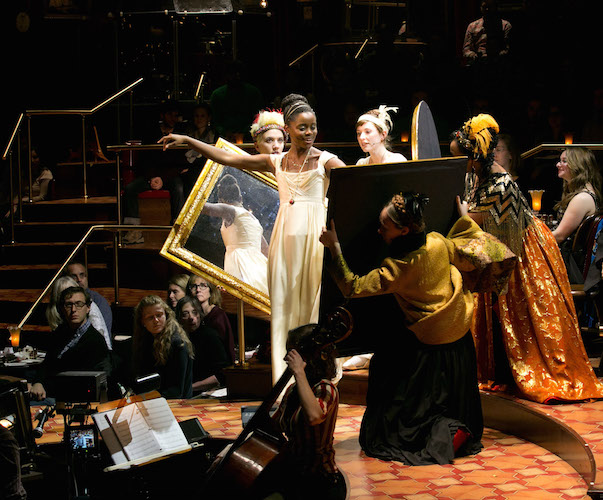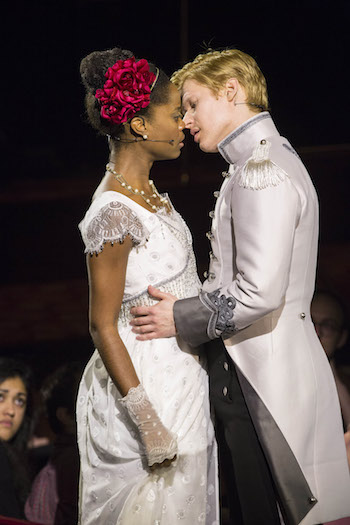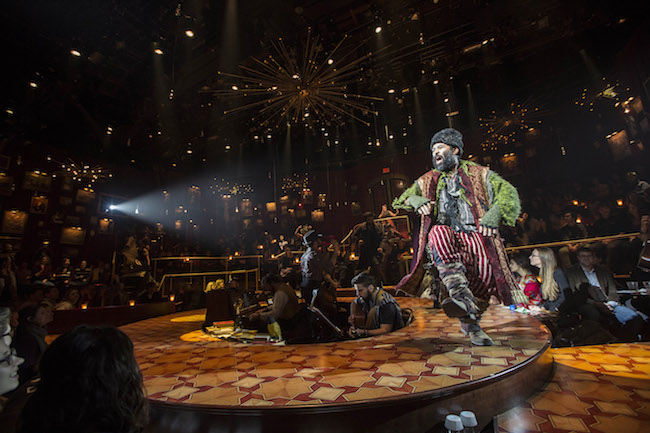Theater Review: “The Great Comet” — Immersive Theater, At Its Best
Who would have guessed that a hunk of War and Peace could be such an enormous amount of fun?
Natasha, Pierre & the Great Comet of 1812 Book, Lyrics and Music by Dave Malloy. Directed by Rachel Chavkin. Presented by the American Repertory Theater at the Loeb Drama Center, Cambridge, MA, through January 3.

Pearl Rhein, Denée Benton, Brittain Ashford, Erica Dorfler, Gelsey Bell in The A.R.T. production of “The Great Comet.” Photo Evgenia Eliseeva/American Repertory Theater.
By Jess Viator
Natasha, Pierre & the Great Comet of 1812 is an astonishing feat of theatrical immersion. This electro-pop opera is an adaptation of a small potion of Tolstoy’s epic novel War and Peace, an episode that revolves around the doings of aristocratic Russian society during the Napoleonic Wars.
When I entered Cambridge’s Loeb Theater to see The Great Comet, I was immediately transported to a Moscow opera house in 1812. The entirety of the theater is adorned in deep red and gold; the walls of the auditorium are covered in rich, burgundy draperies and strewn with gilded, framed paintings. The stage has been reconstructed to include an orchestra pit in the center as well as runways that serve as playing spaces for the actors. Tiers of seats for the audience are part of the holistic design. (Small rostra have been built into the conventional seating area.) The performance space and spectators are scrambled together; Mimi Lien’s transformative set is specifically designed to erase the barrier between viewers and actors. Audience members are invited to be participants in the play.
While walking to my seat, two of the framed pictures stood out to me: “Unequal Marriage,” the 1862 classic by Vasily Pukirev that depicts an impossibly pale and weeping young bride in the midst of her wedding ceremony (she is marrying a prune-faced man in his 70s); and a photo of supporters (who are wearing bright-colored, face-masks, bound in chains and gagged) of the Russian activist punk band Pussy Riot. The first painting is intended to be a scathing commentary on the oppressive society of 19th Century Russia; the second image is of a protest against the arrest and detainment of the band members for speaking out against the persecution of LGTB people by the current Russian government. These two paintings are a distillation of the energy that drives The Great Comet: the show juxtaposes the unrest of the past with the dissent of the present.
Notions of current day provocation and bygone rebellion are intermingled throughout the production. The time-tripping impression is initially made, memorably, through Paloma Young’s astute costuming of the ensemble. The major characters are garbed in sumptuous 19th century aristocratic frocks, while the ensemble’s costumes are accented with punk touches: there are back patches, combat boots, and studded belts. The punk imagery is used as a means to renovate the past: the chorus members are seen as youthful rebels, brimming with a contemporary sensibility. They are our hip gateway into a book that many attendees might (if they had read it) find stodgy and old-fashioned. (And the ensemble members serve pierogies to the audience members — that will win anyone over.)

Denée Benton (Natasha) and Lucas Steele (Anatole) in The A.R.T. production of “The Great Comet.” Photo: Gretjen Helene/American Repertory Theater.
This smart mixture of modernity and age is also expressed, brilliantly, in Dave Malloy’s musical score and lyrics. The Great Comet is billed as an opera, and it has some traditional qualities of the genre: all of the text is sung. But the infectious and exhilarating score spans genres like Russia spans Asia: a little bit of bluegrass here, a smidgen of cossack there, a pinch of Adele in this spot, then a drop of EDM. Also, the show is helpfully self-conscious about its intimidating source material: a door stopper of a classic that deals with the well-tread topic of forbidden love and ruin. The Great Comet brings a comfy, postmodern approach to telling Tolstoy’s story — nobody wants the audience to feel that it is bogged down. The characters exist on a meta-level: they are aware that they are actors in an opera. In the prologue, the ensemble helpfully sings, “This is a complicated Russian novel, every one’s got nine different names, so look it up in your program, we appreciate it thanks a lot.”
All of the performers are actor-musicians; even when they are not at the center of the action, they help tell the story, sometimes through acting and singing, sometimes by playing their instruments. Director Rachel Chavkin also uses the ensemble members to actively encourage the audience’s engagement in the production. Actors frequently interact with viewers. For example, in one scene the performers explain how, 200-years ago, people communicated through letter-writing. One of them delivered a letter to me with a flirtatious smirk. Later, another actor offered us egg shakers, and instructed us on how we could add our percussion oomph to the music. The aim is not just to acknowledge the presence of audience members, but to invite them into creating the drama. None of this interactivity seems forced — it is always affable, to the point that the cooperation generates plenty of camaraderie between actors and audience members.
The Great Comet centers on Natasha, a young woman who is newly engaged, but whose fiancé is far away, fighting in the war. She visits her godmother in Moscow, who introduces her into society. While attending the opera one night Natasha meets the dashing Anatole, who pursues her. They fall in love. Natasha wants to run away with Anatole even though their romance will destroy her reputation. This tale of illicit love and loss is traditional and universal, but The Great Comet doesn’t lapse into familiarity. For example, Natasha and Anatole’s meeting doesn’t feel tired: the seduction takes place at the ball, which here is more like a dance club, complete with strobe lights. The love story is given a well-paced and believable arc; though the relationship develops over the course of 3 days, the beats of the relationship — courting, resisting, giving in, falling in love — seem completely plausible. Much of the credit must go to the actors’ skill as well as to the felicity of their combined chemistry; Denée Benton is intensely charismatic as Natasha, winning you over even when she is being petulant, and Lucas Steele as Anatole is a smugly handsome rascal through and through.
Spectacle is an important element in The Great Comet. The actors are in every corner of the theater, moving and dancing and singing and playing. At times the energy is so off the charts that the experience becomes overwhelming. But there are other moments in the show that are refreshingly quiet and intimate. The deeply moving tune “Sonya Alone” provides that kind of blissfully introspective interlude. In a score filled with memorable music, this number is the obvious showstopper. “Sonya Alone” is sung by Brittain Ashford, who plays Sonya, Natasha’s cousin and best friend. Ashford brings a powerful and distinctive voice to her rendition; she suggests that there is an intense, visceral passion bottled up inside of Sonya, which smolders, ignites, and then explodes.

Paul Pinto (Balaga) in The A.R.T. production of “The Great Comet.” Photo: Gretjen Helene/American Repertory Theater.
Bradley King’s masterful lighting design helps The Great Comet transition between these small, profound moments and the times when the full-cast extravaganza takes over. Because the set takes up the entire room, it is occasionally difficult to know exactly where to direct your attention. The lights come to the rescue, guiding the audience’s gaze with pin point precision. The lighting also conjured up the show’s mysterious atmosphere — it bathes some scenes in moonlight, makes the stars sparkle, transports us to a debaucherous discotheque, and highlights Anatole’s entrance with a hauntingly smoky back light. And, of course, the lighting embodies the arrival of the great comet itself.
The title of the play is Natasha, Pierre & the Great Comet, but I have made little mention of either Pierre or the comet. Pierre, played by Scott Stangland, indeed serves as the through-line of the narrative. His story intertwines with Natasha’s, though he is an observer, well outside of the turmoil, much of the time. Stangland’s rendition of “Ready to Wake Up,” a requiem to missing out on love and life, is truly heartbreaking. Pierre is deeply unhappy and spiritually lost; the unconventional Natasha spins into his life and crashes at his feet.
Eventually, the poor milquetoast becomes involved in the story in a powerful way. His anger at Anatole’s behavior is shocking and scary. It is also dramatically essential: social mores have changed enormously since the late 19th century. Giving Pierre a scene where he blows up clarifies just how much is at stake — what it means for a woman to have a ruined reputation. The idea may seem silly and dated to us now, but when Pierre becomes so furious he becomes unhinged it drives home the severity of the situation. In the end, Natasha has shaken up Pierre, and has possibly inspired in him a rebellion of his own.
Natasha, Pierre & the Great Comet of 1812 is an impressive theatrical achievement in a number of ways. Director Chavkin has taken Malloy’s very risky concept — a fusion of opera, Tolstoy, and immersive theater — and has created an interactive production that isn’t over-anxious to please. The show is compelling, exciting, and welcoming. Who would have guessed that a hunk of War and Peace could be such an enormous amount of fun?
Jess Viator is an emerging independent theater director, an occasional stage manager, and a lapsed playwright. She has a BA in theater performance, and recently completed a master’s degree in theatre studies from the University of Dundee in Scotland.
